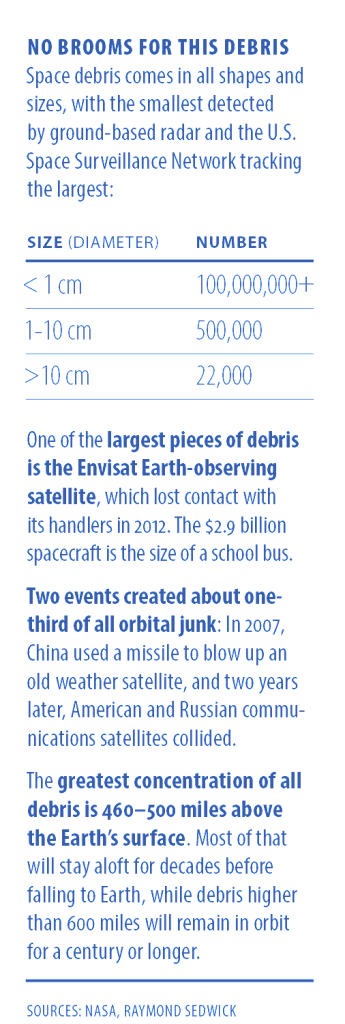- October 05, 2014
- By David Kohn
In 1957, space was utterly, pristinely free of humanity. The Russians sent up Sputnik that year, and since then, humans have polluted space with all manner of flying machines and the junk that breaks or falls from them. These millions of objects, including rocket boosters, fuel tanks, screws, paint flecks, even a spatula, zoom around the Earth at speeds of up to 25,000 mph.
This ever-growing detritus could collide with satellites or other spacecraft, experts say. If left unchecked, it has the potential to eventually cripple global communications and space-based scientific research.
“The risks are growing,” says Raymond Sedwick, associate professor of aerospace engineering. “If we don’t deal with it, eventually it’ll be too late.”
He recently launched the Center for Orbital Debris Education and Research (CODER), which he hopes will become a focal point for academic, industry and government research collaboration.
“There is a real need for a center like this,” says David Spencer, a professor of aerospace engineering at Penn State University who has been studying space debris for more than 30 years. “Right now we don’t have a centralized clearinghouse that includes private industry, government and academia. I think this center will do that.”
 Sedwick first began working on the issue when he teamed up with a small aerospace company to develop a vehicle that could guide large pieces toward the atmosphere, where they would burn up during re-entry. The project was discontinued, but Sedwick was hooked.
Sedwick first began working on the issue when he teamed up with a small aerospace company to develop a vehicle that could guide large pieces toward the atmosphere, where they would burn up during re-entry. The project was discontinued, but Sedwick was hooked.
He realized that although several government agencies and the military are working on the problem, there was no academic center devoted to space debris. He and his colleague Marshall Kaplan, a visiting professor of aerospace engineering at UMD, set out to close this gap, and in May, after two years of planning, CODER was born. Sedwick is now talking to industry and government agencies about funding for specific projects.
The most pressing issue is the several hundred pieces that are the size of a car or larger. The larger the object, the more likely that a collision with a working satellite will produce more debris. Reducing this risk will require removing many of these large objects from orbit. Possible solutions include attaching sails or tethers to the objects to change their trajectory.
But the center won’t only look for technological solutions; Sedwick says CODER will also examine the issue from scientific, legal and economic angles. For instance, he says, it’s unclear whether one country is allowed to clean up the rubbish left by another.
“Who’s in charge of cleaning up orbital debris?” he says. “There is no agreement. Even within our own government there is no policy on this. Is it NASA? Is it the Department of Defense? There is so much we need to figure out.”
